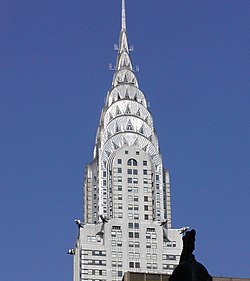Art Deco (French: Exposition Internationale des Arts Décoratifs et Industriels Modernes) also known as Style Moderne or 1925 Style, was a twentieth century movement in the decorative arts that grew to influence architecture, design, fashion and the visual arts.


History
The name Art Deco derived from the Exposition Internationale des Arts Décoratifs et Industriels Modernes, a World's Fair held in Paris, France in 1925, though the term was not used prior to the late 1960s. Art Deco was influenced by many different cultures, particularly pre-World War I Europe. The movement occurred at the same time as, and as a response to, the rapid social and technological advances of the early 20th century.
Paris was at the center of the high end of Art Deco design, epitomized in furniture by Jacques-Emile Ruhlmann, the best-known of Art Deco furniture designers and perhaps the last of the traditional Parisian ébénistes, and Jean-Jacques Rateau, the firm of Süe et Mare, the screens of Eileen Gray, wrought iron of Edgar Brandt, metalwork and lacquer of Jean Dunand, the glass of René Lalique and Maurice Marinot, clocks and jewelry by Cartier.
The term Art Deco was coined during the Exposition of 1925 but did not receive wider usage until it was re-evaluated in the 1960s. Its practitioners were not working as a coherent community. It is considered to be an eclectic form of decorative Modernism, being influenced by a variety of sources. Among them were the "primitive" arts of Africa, Egypt, or Aztec Mexico, as well as machine age technology such as the radio and skyscraper. These were expressed in fractionated, crystalline, faceted form of decorative Cubism and Futurism, in Fauvism's palette.
Sources and attributes
Corresponding to these influences, Art Deco is characterized by use of materials such as aluminum, stainless steel, lacquer, inlaid wood, sharkskin (shagreen), and zebraskin. The bold use of zigzag and stepped forms, and sweeping curves (unlike the sinuous curves of the Art nouveau), chevron patterns, and the sunburst motif are typical of Art Deco. Some of these motifs were ubiquitous — for example the sunburst motif was used in such varied contexts as a lady's shoe, a radiator grille, the auditorium of the Radio City Music Hall and the spire of the Chrysler Building.
Art Deco was an opulent style and this lavishness is attributed to reaction of the forced austerity caused by World War I. Its rich, festive character fitted it for "modern" contexts including interiors of cinema theaters and ocean liners such as the Ile de France and Normandie. A parallel movement called Streamline Moderne or simply Streamline followed close behind. Streamline was influenced by manufacturing and streamlining techniques arising from science and the mass production shape of bullet, liners, etc., where aerodynamics are involved. Once the Chrysler Airflow design of 1933 was successful, "streamlined" forms began to be used even for objects such as pencil sharpeners and refrigerators.
Decline
Art Deco slowly lost patronage in the West after reaching mass production, where it began to be derided as gaudy and presenting a false image of luxury. Eventually the style was cut short by the austerities of World War II. In colonial countries such as India, it became a gateway for Modernism and continued to be used well into the 1960s. A resurgence of interest in Art Deco came with graphic design in the 1980s, where its association with film noir and 1930s glamour led to its use in ads for jewelry and fashion. South Beach, Miami, FL has the largest remaining collection of Art Deco architecture remaining in North America.
In popular culture
Art Deco designs frequently appear in modern art, architecture, entertainment, and media when a "retro" look is sought after. Some of the more pronounced examples include:
- The Batman animated series from the early 1990's was heavily influenced by art deco. The creators of the show pushed Art Deco a step further into a form they refer to as Dark Deco
- The computer game Sim City 4 makes heavy use of Art Deco buildings.
- The architecture and design in Grim Fandango, a computer game from LucasArts, are in the Art Deco style.
- The film Sky Captain and the World of Tomorrow takes place in an almost entirely Art Deco environment.
- The opening and closing titles of Peter Jackson's King Kong are designed in an Art Deco style, as was the film's website.
- Most Regal Entertainment Group cinemas are designed with an Art Deco theme.
- Much of the recent development in the city of Long Beach, California has been in an Art Deco-like postmodern style.
- Downtown Disney in Anaheim, California has an Art Deco-themed section.
- The imagery of Marilyn Manson's "The Golden Age of Grotesque" has quite a modern Art Deco style mixed with his gothic trademark.